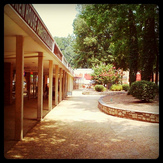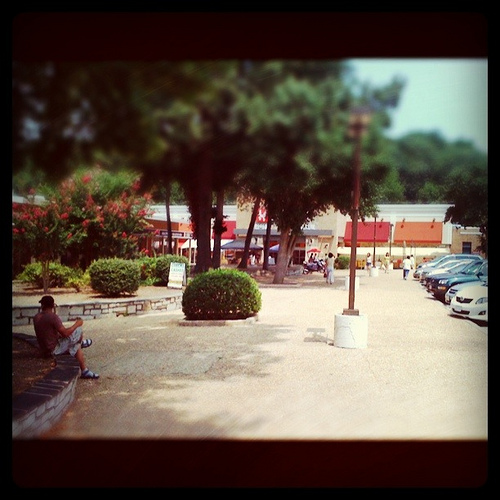A strip mall also becomes a community gathering spot
How do you turn a typical suburban strip mall into a vibrant gathering space? At one shopping center in Fairfax County, it’s done by making room for people in addition to cars.
Heritage Center is a 1970s-era shopping strip off Little River Turnpike in Annandale, in an area dubbed “Koreatown” for its large Korean community. Like many retail complexes from this time, Heritage Center is set far back from the street behind a large parking lot.
But between the parking and the stores there is a large, tree-studded plaza that seems to have become a local meeting spot. There families eat lunch, neighbors mingle, and little kids play.
Landscaped plazas are a common feature of recently-built suburban “town centers” like The Market Common at Clarendon, which have upscale stores aimed at drawing well-heeled customers from a wide area. At these town centers, the provision of public space and a walkable environment is meant to be the main draw.
At Heritage Center the plaza is secondary to the neighborhood-serving shops, which include a CVS/pharmacy, a laundromat, a Peruvian restaurant, and Korean grocery chain H-Mart as an anchor. These shops would draw customers even if there wasn’t an attractive green space at their door.
So why is this space so popular? The answer lies in its design and the changing demographics of the surrounding area.
The plaza at Heritage Center is simple. It’s a long, narrow space, bounded on three sides by the H-Mart, two retail buildings, and an office building built after the rest of the complex. The fourth side is a parking lot. A few clusters of tall, mature trees provide shade and define the space, obscuring views of the cars. The trees sit in raised beds of landscaping and mulch that are large enough for kids to run around in. Stone ledges ring the planted areas and serve as benches.
In front of the retail buildings is a long, covered arcade, giving the complex a sort of “front porch.” Throughout the plaza are wide, twenty-five-foot sidewalks, providing more than enough room to walk and gather. The result is a comfortable, shady space that invites people rather than pushes them away.
It also helps that the surrounding neighborhood is pretty dense by suburban standards, providing a built-in customer base for Heritage Center. A mix of apartment and townhouse complexes push the population density to over 15,000 people per square mile, comparable to many neighborhoods in the District. The area is pretty auto-oriented, however. 86% of residents drive to work according to the 2009 American Community Survey.
Despite its suburban character, the area is not a terrible place to walk around. There’s a network of paved sidewalks and informal “desire paths” that cut through the residential areas and tie into Heritage Center. Across the street from the strip mall is Annandale High School, whose 2,200 students can walk there for lunch and after school. A church and recreational park give people more reasons to pass through Heritage Center while in the area.
The area’s demographics might also explain why the plaza is so well-used. With a median income of $54,263, the neighborhood has half the average spending power of Fairfax County at large, which is the nation’s third-wealthiest county. There’s a relatively low-income community around Heritage Plaza that may be more likely to walk instead of drive for short distance trips.
35% of the neighborhood’s 7,276 residents are Hispanic or Latino, while 22% are Asian. Overall, 61% of residents speak a language other than English at home. In a study on immigrants and Smart Growth, former University of Maryland professor Shenglin Chang found that Latinos and Asians who emigrate from urban areas want to retain the convenience and vitality of those places when they come to the United States, even while embracing the “American Dream” of a suburban, single-family home. Heritage Center lets them live in a leafy suburb while being able to walk to shops and meet friends and family in a semi-urban space.
As the greater Washington region becomes majority-minority, demand for public spaces where people can mingle and hang out will grow, especially outside of traditionally urban neighborhoods where such places may already exist. Heritage Center is an example of how to create a vibrant public space, albeit on private property, in suburban communities. We’ll need to make more places like it in the future.




